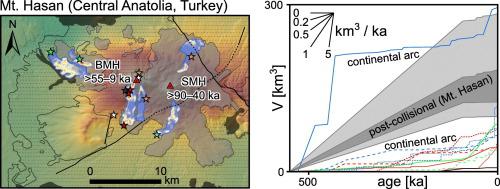当前位置:
X-MOL 学术
›
J. Volcanol. Geotherm. Res.
›
论文详情
Our official English website, www.x-mol.net, welcomes your
feedback! (Note: you will need to create a separate account there.)
Late Pleistocene eruptive recurrence in the post-collisional Mt. Hasan stratovolcanic complex (Central Anatolia) revealed by zircon double-dating
Journal of Volcanology and Geothermal Research ( IF 2.4 ) Pub Date : 2020-10-01 , DOI: 10.1016/j.jvolgeores.2020.107007 Bjarne Friedrichs , Gokhan Atıcı , Martin Danišík , Evren Atakay , Mehmet Çobankaya , Janet C. Harvey , Esra Yurteri , Axel K. Schmitt
Journal of Volcanology and Geothermal Research ( IF 2.4 ) Pub Date : 2020-10-01 , DOI: 10.1016/j.jvolgeores.2020.107007 Bjarne Friedrichs , Gokhan Atıcı , Martin Danišík , Evren Atakay , Mehmet Çobankaya , Janet C. Harvey , Esra Yurteri , Axel K. Schmitt

|
Abstract Mt. Hasan (3262 m) is the second highest stratovolcano in Central Anatolia, Turkey, and is considered active based on a ca. 9 ka explosive summit eruption that was arguably depicted in a Neolithic mural at the nearby Catalhoyuk archaeological site. Besides evidence for Holocene activity of Mt. Hasan, its eruptive chronostratigraphy and hazard potential remain poorly constrained. Here, we apply (U-Th)/He thermochronology in combination with U-Th-Pb crystallization ages (zircon double-dating), including a novel population-based approach to disequilibrium correction of (U-Th)/He data, in an attempt to determine the eruption ages of strategically sampled lavas and pyroclastic deposits and to refine the Late Pleistocene chronostratigraphy of Mt. Hasan. During the Late Pleistocene, Mt. Hasan erupted multiple interfingering andesitic lava flows along with block-and-ash-flows. Seven of these lava flows, typically the stratigraphically youngest in a particular segment around the two central vents of the volcano, yielded Late Pleistocene eruption ages between 91.9 ± 3.9 and 18.1 ± 2.4 ka (uncertainties stated at 1σ). An even younger block-and-ash-flow was deposited on the western flank of the volcano at 13.5 ± 1.5 ka, which together with a ca. 9 ka small-volume explosive summit eruption define the youngest activity at the main edifice of Mt. Hasan. Collectively, these data indicate a Late Pleistocene recurrence of at least one eruptive phase every ca. 5–15 ka. New volume estimates for the Quaternary edifice of ~130–180 km3 translate into an integrated long-term eruptive magma flux of ~0.3 km3/ka, which is just slightly higher than Late Pleistocene flux estimates based on lava flow geochronology and volumes determined by analysis of digital elevation models. This long-term eruptive flux estimate is similar to those of stratovolcanoes in continental arcs, indicating that eruptive productivity in post-collisional settings can match that of active continental margins. All Mt. Hasan eruptions, including the Holocene event, sampled zircon which crystallized coeval with earlier eruptive phases, indicating longevity of the magma plumbing system. Along with ongoing fumarole activity and evidence for mid-crustal low seismic velocity zones, this suggests that a subvolcanic magma reservoir remains active to the present day.
中文翻译:

后碰撞山的晚更新世喷发复发。锆石双测年揭示哈桑成层火山杂岩(安纳托利亚中部)
摘要山 Hasan (3262 m) 是土耳其安纳托利亚中部第二高的成层火山,根据约 在附近的 Catalhoyuk 考古遗址的新石器时代壁画中可以说是 9 ka 爆炸性的山顶喷发。除了 Mt. 全新世活动的证据。哈桑,其爆发性年代地层学和潜在危险仍然受到很大限制。在这里,我们应用 (U-Th)/He 热年代学与 U-Th-Pb 结晶年龄(锆石双测年)相结合,包括一种基于群体的新方法来校正(U-Th)/He 数据的不平衡,在试图确定战略取样的熔岩和火山碎屑沉积物的喷发年龄,并完善 Mt. 的晚更新世年代地层学。哈桑。在晚更新世期间,山。哈桑喷发了多条相互交错的安山岩熔岩流以及块状火山灰流。其中七个熔岩流,通常是火山两个中央喷口周围特定段中地层上最年轻的,产生了 91.9 ± 3.9 和 18.1 ± 2.4 ka 之间的晚更新世喷发年龄(不确定性在 1σ 处表示)。在 13.5 ± 1.5 ka 的火山西侧沉积了一个更年轻的块状火山灰流,连同大约 9 ka 小体积爆炸性山顶喷发定义了山主要建筑中最年轻的活动。哈桑。总的来说,这些数据表明,每大约一个喷发阶段,晚更新世都会复发。5-15 卡。对约 130-180 平方公里的第四纪大厦的新体积估计转化为约 0.3 平方公里/ka 的综合长期喷发岩浆通量,这仅略高于基于熔岩流地质年代学和数字高程模型分析确定的体积的晚更新世通量估计值。这种长期的喷发通量估计类似于大陆弧中层状火山的喷发通量,表明碰撞后环境中的喷发生产力可以与活动大陆边缘的喷发生产力相匹配。所有山 哈桑喷发,包括全新世事件,采样了与早期喷发阶段同时结晶的锆石,表明岩浆管道系统的寿命。随着持续的喷气孔活动和中地壳低地震速度带的证据,这表明一个火山岩下的岩浆储层直到今天仍然活跃。这种长期的喷发通量估计类似于大陆弧中层状火山的喷发通量,表明碰撞后环境中的喷发生产力可以与活动大陆边缘的喷发生产力相匹配。所有山 哈桑喷发,包括全新世事件,采样了与早期喷发阶段同时结晶的锆石,表明岩浆管道系统的寿命。随着持续的喷气孔活动和中地壳低地震速度带的证据,这表明一个火山岩下的岩浆储层直到今天仍然活跃。这种长期的喷发通量估计类似于大陆弧中层状火山的喷发通量,表明碰撞后环境中的喷发生产力可以与活动大陆边缘的喷发生产力相匹配。所有山 哈桑喷发,包括全新世事件,采样了与早期喷发阶段同时结晶的锆石,表明岩浆管道系统的寿命。随着持续的喷气孔活动和中地壳低地震速度带的证据,这表明一个火山岩下的岩浆储层直到今天仍然活跃。采样的锆石与早期的喷发阶段同时结晶,表明岩浆管道系统的寿命。随着持续的喷气孔活动和中地壳低地震速度带的证据,这表明一个火山岩下的岩浆储层直到今天仍然活跃。采样的锆石与早期的喷发阶段同时结晶,表明岩浆管道系统的寿命。随着持续的喷气孔活动和中地壳低地震速度带的证据,这表明一个火山岩下的岩浆储层直到今天仍然活跃。
更新日期:2020-10-01
中文翻译:

后碰撞山的晚更新世喷发复发。锆石双测年揭示哈桑成层火山杂岩(安纳托利亚中部)
摘要山 Hasan (3262 m) 是土耳其安纳托利亚中部第二高的成层火山,根据约 在附近的 Catalhoyuk 考古遗址的新石器时代壁画中可以说是 9 ka 爆炸性的山顶喷发。除了 Mt. 全新世活动的证据。哈桑,其爆发性年代地层学和潜在危险仍然受到很大限制。在这里,我们应用 (U-Th)/He 热年代学与 U-Th-Pb 结晶年龄(锆石双测年)相结合,包括一种基于群体的新方法来校正(U-Th)/He 数据的不平衡,在试图确定战略取样的熔岩和火山碎屑沉积物的喷发年龄,并完善 Mt. 的晚更新世年代地层学。哈桑。在晚更新世期间,山。哈桑喷发了多条相互交错的安山岩熔岩流以及块状火山灰流。其中七个熔岩流,通常是火山两个中央喷口周围特定段中地层上最年轻的,产生了 91.9 ± 3.9 和 18.1 ± 2.4 ka 之间的晚更新世喷发年龄(不确定性在 1σ 处表示)。在 13.5 ± 1.5 ka 的火山西侧沉积了一个更年轻的块状火山灰流,连同大约 9 ka 小体积爆炸性山顶喷发定义了山主要建筑中最年轻的活动。哈桑。总的来说,这些数据表明,每大约一个喷发阶段,晚更新世都会复发。5-15 卡。对约 130-180 平方公里的第四纪大厦的新体积估计转化为约 0.3 平方公里/ka 的综合长期喷发岩浆通量,这仅略高于基于熔岩流地质年代学和数字高程模型分析确定的体积的晚更新世通量估计值。这种长期的喷发通量估计类似于大陆弧中层状火山的喷发通量,表明碰撞后环境中的喷发生产力可以与活动大陆边缘的喷发生产力相匹配。所有山 哈桑喷发,包括全新世事件,采样了与早期喷发阶段同时结晶的锆石,表明岩浆管道系统的寿命。随着持续的喷气孔活动和中地壳低地震速度带的证据,这表明一个火山岩下的岩浆储层直到今天仍然活跃。这种长期的喷发通量估计类似于大陆弧中层状火山的喷发通量,表明碰撞后环境中的喷发生产力可以与活动大陆边缘的喷发生产力相匹配。所有山 哈桑喷发,包括全新世事件,采样了与早期喷发阶段同时结晶的锆石,表明岩浆管道系统的寿命。随着持续的喷气孔活动和中地壳低地震速度带的证据,这表明一个火山岩下的岩浆储层直到今天仍然活跃。这种长期的喷发通量估计类似于大陆弧中层状火山的喷发通量,表明碰撞后环境中的喷发生产力可以与活动大陆边缘的喷发生产力相匹配。所有山 哈桑喷发,包括全新世事件,采样了与早期喷发阶段同时结晶的锆石,表明岩浆管道系统的寿命。随着持续的喷气孔活动和中地壳低地震速度带的证据,这表明一个火山岩下的岩浆储层直到今天仍然活跃。采样的锆石与早期的喷发阶段同时结晶,表明岩浆管道系统的寿命。随着持续的喷气孔活动和中地壳低地震速度带的证据,这表明一个火山岩下的岩浆储层直到今天仍然活跃。采样的锆石与早期的喷发阶段同时结晶,表明岩浆管道系统的寿命。随着持续的喷气孔活动和中地壳低地震速度带的证据,这表明一个火山岩下的岩浆储层直到今天仍然活跃。











































 京公网安备 11010802027423号
京公网安备 11010802027423号